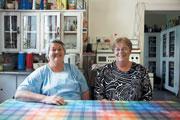You won’t find the Boonzaaier sisters’ Van der Hum liqueur on your supermarket shelf. But you can make it yourself with their popular recipe
HILARY PRENDINI TOFFOLI
It was at the monthly morning market in the West Coast village of Darling that I first came across Hilda and Maria Boonzaaier. They were selling their homemade wares at a stall. Two jolly, generously built, middle-aged country women, joking with the buyers of their Van der Hum with as much robust good humour as the BBC food channel’s famous Two Fat Ladies. I’ve been buying Boonzaaier booze products ever since. They make great gifts and are delicious as after-dinner digestifs. They’re so popular you even find them in Darling’s museum shop. Hilda and Maria make a wide variety, with different fruits and different spirit bases.
My Italian husband says their lemon liqueur is better than most of the imported limoncellos you buy locally. Hilda is the one who started it all in her kitchen years ago. “She originally just wanted to make them as gifts,” her older sister Maria tells me when I visit them in their little white house, set among ancient fruit trees on the hill. They’ve lived in this house since the family came here from the Eastern Cape before Hilda was born.
Their father was the new teacher for the pretty schoolhouse down the road – now the elegant home of the owner of Darling’s Marmalade Cat – and their mother became the church organist. The two sisters are the only ones left. “Mama used to welcome new arrivals to Darling with a basket of guavas from our garden, and then ask them if they were joining the church choir,” Maria says with a happy chuckle, tucked comfortably into a plump old Art Deco chair in the living room. “Mama was a very fine pastry baker; famous for her pies and melktert. A few days before Hilda was born she baked 12 dozen chicken pies for the Darling gymkhana.” Her daughters decided they were not great pastry chefs, so they only bake her buttermilk tart, which doesn’t have a pastry base. “It’s even more delicious than her melktert,” Hilda says.
They both became school teachers. Maria teaches Grade 4 in Wellington and Hilda teaches music in Bellville. But every weekend they come home to Darling, where Hilda plays the organ in the church. “We love Darling,” she says. “We love the feeling of a small town where you know everyone.” “We always take four chairs to the market because we want people to sit down and talk,” Maria adds. Actually, the first thing people do at their stall is to buy a Boonzaaier bread wheel. These spirals filled with bacon, onion and cheese make such a tasty morning market munch that they’ve been a sell-out since day one. Occasional leftovers go to the village’s senior citizens. But what the sisters are really famous for, along with their sticky ruby grapefruit marmalade, are their liqueurs. They put them in recycled 200ml brandy bottles with new labels reading Bee’s Hiccup, Made in Darling.
They even make a brandy-based cream liqueur, but only on order. They are not made from old family recipes – their origin is more prosaic. “I found this book Maak Jou Eie Likeur [Make Your Own Liqueur] by Jean Dickson,” Hilda explains. “So I started with the green fig liqueur made with gin and fig leaves. It was lovely. I took a bottle to friends for dinner and they served it over the ice cream.” The liqueurs mature in three-litre jars for anything from two weeks to three months. If they have to be shaken daily, Maria takes them with her to Wellington where they sit on a warm window sill while she’s teaching.
They don’t drink the stuff themselves. Nor is it exactly a money-spinner, at R24 a bottle. “We do it because we like to keep busy,” Maria says. You can’t help thinking that they’re an endangered species, these industrious, salt-of-the-earth, strong-minded women with their heartfelt old-fashioned values. Hilda even smokes her snoek herself, in a simple sawdust smoker, and makes a delicious homely smoked snoek tart. “The nice thing about snoek is that you can debone it and freeze it in portions. We get it from our friend Biesie Genade. He buys a boatful from the fishermen at Yzerfontein for the labourers at Groote Post wine estate where he’s foreman, and he always drops some off for us. Then I get to work.”
SOURCES
MIKE ROSE

